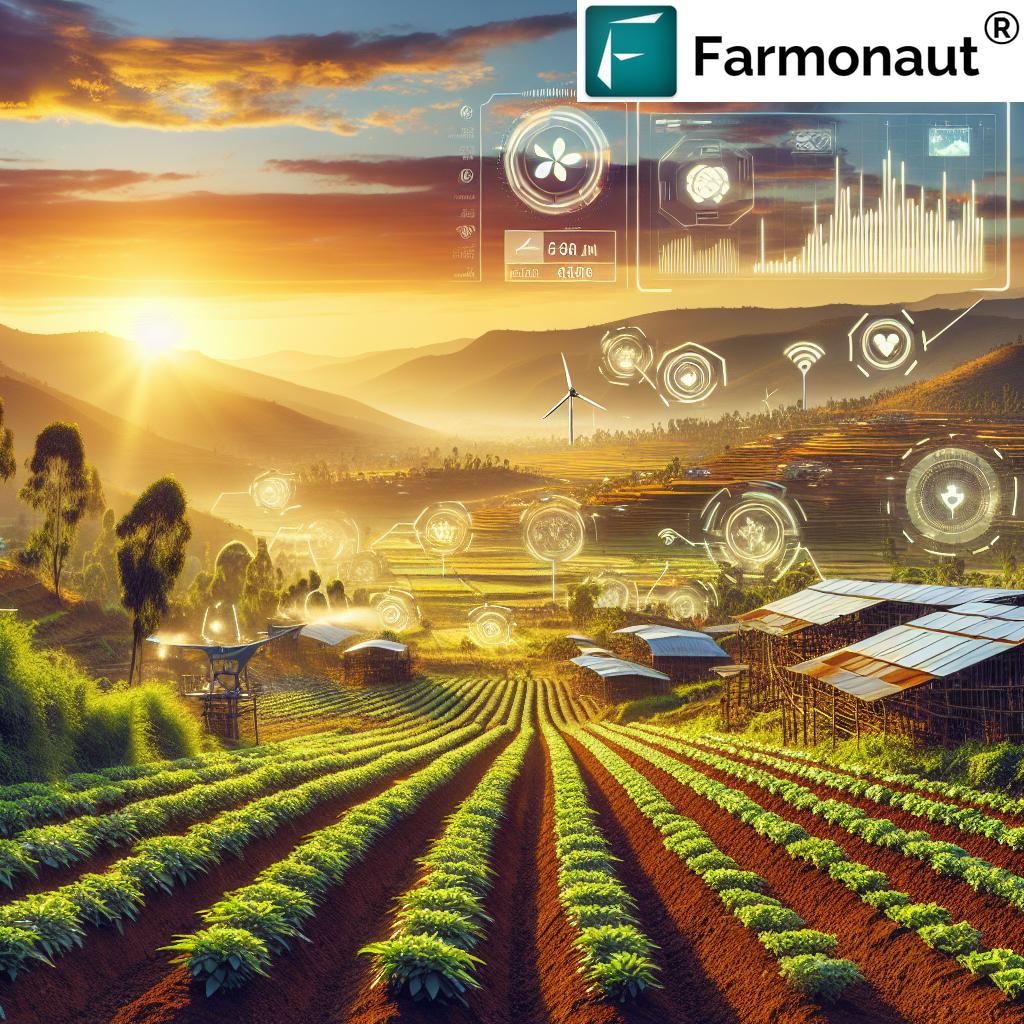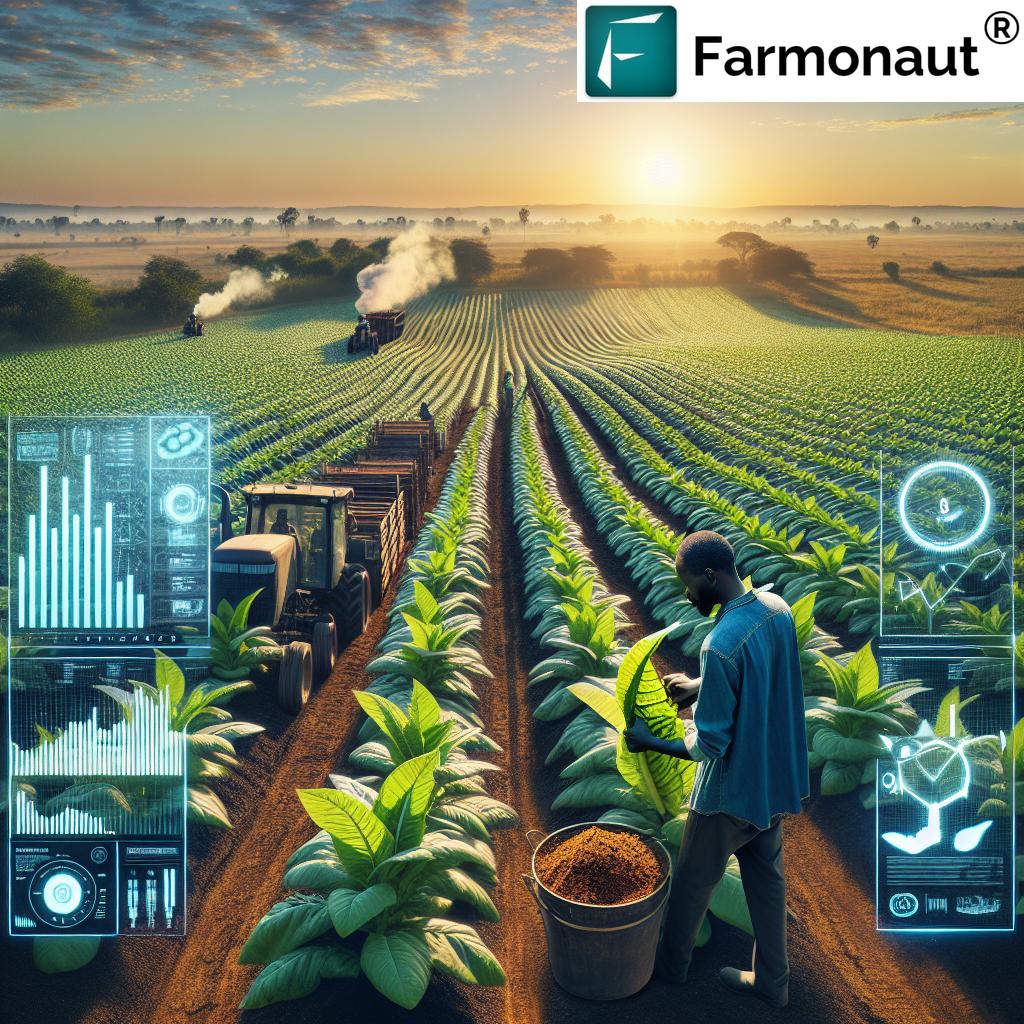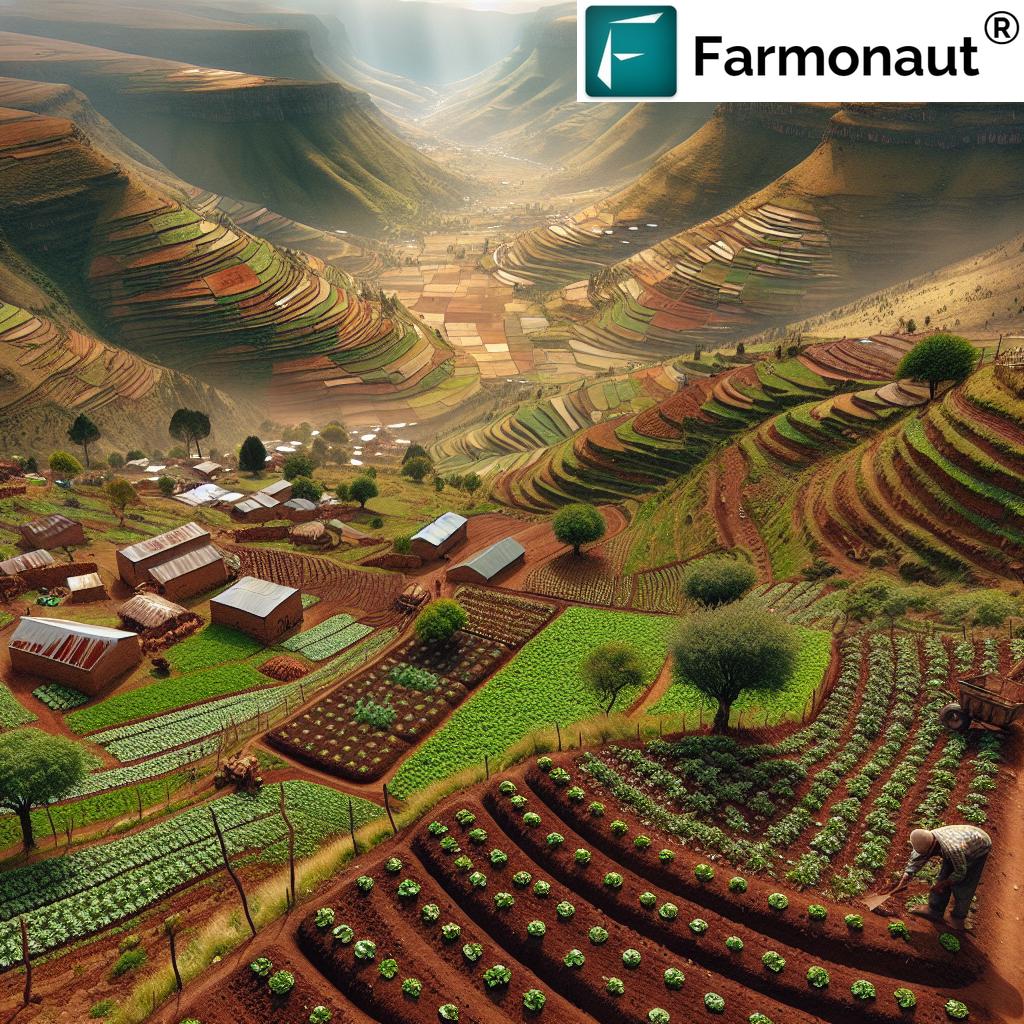Algeria, Australia, Ethiopia Wheat Production 2025 Trends: Global Outlook & Comparative Analysis
“Australia is projected to outproduce Algeria and Ethiopia in wheat by over 20 million tonnes in 2025.”
Table of Contents
- Introduction: Wheat’s Global Significance in 2025
- Trivia: Australia’s Lead in Wheat Output
- Comparative Trend Table: 2025 Wheat Production Analysis
- Algeria Wheat Production 2025: Striving Beyond Limits
- Australia Wheat Production 2025: Robust Growth Amid Climatic Hurdles
- Ethiopia Wheat Production 2025: Agronomic Evolution & Food Security
- Global Trade, Food Security & Wheat Markets in 2025
- Technology & Satellite Monitoring: Enabling the Future of Wheat
- Farmonaut: Transforming Smart Agriculture & Resource Management
- FAQ: Wheat Production Analysis 2025
- Conclusion: Navigating Food Security with Insight
Introduction: Wheat’s Global Significance in 2025
Wheat remains one of the world’s most vital cereal crops, serving as a staple food for billions while also being a key commodity that shapes global trade, food security, and agriculture. As we approach 2025, stakeholders—including farmers, government bodies, businesses, and technology firms—closely monitor the wheat production trends in Algeria, Australia, and Ethiopia. These three countries present contrasting scenarios, driven by climate, technology, policy, and economic factors.
Understanding the dynamics of algeria wheat production 2025, australia wheat production 2025, and ethiopia wheat production 2025 is critical for stakeholders involved in agriculture, food security, and international trade. This blog offers a detailed exploration of expected trends, climatic challenges, and the role of emerging technology in shaping the future outlook for these regions.
Trivia: Australia Dominates Wheat Output
“Australia is projected to outproduce Algeria and Ethiopia in wheat by over 20 million tonnes in 2025.”
Comparative Trend Table: 2025 Wheat Production Analysis
Before diving deeper into individual country trends, let’s examine the projected production and qualitative insights for algeria wheat production 2025, australia wheat production 2025, and ethiopia wheat production 2025.
| Country | Projected Wheat Production (2025, million metric tons) |
% Change from 2024 |
Major Climate Factors | Key Technological Advancements | Food Security Impact |
|---|---|---|---|---|---|
| Algeria | 3.9 | +4% | Limited rainfall, hot/dry summers, Mediterranean variability | Drought-resistant wheat varieties, improved irrigation, infrastructure upgrades | Continued import dependence; modest improvement in domestic self-sufficiency |
| Australia | 28.7 | +3% | Droughts, unpredictable rainfall, rising temperatures, heatwaves | Precision agriculture, satellite/AI monitoring, climate-resilient crop varieties | Major exporter; crucial for regional/global wheat trade stability |
| Ethiopia | 5.1 | +10% | Erratic rainfall, altitude diversity, climate vulnerability | Improved disease-resistant varieties, extension services, early mechanization | Bolstering food security; narrowing gap with Algeria |
Algeria Wheat Production 2025: Striving Beyond Limits
Key Challenges and Factors Influencing Algeria’s Wheat Outlook
Algeria is a significant consumer of wheat but faces persistent challenges in achieving self-sufficiency. By 2025, Algeria’s wheat production is expected to see only modest improvements, due largely to limited arable land (much of it semi-arid), erratic rainfall, and recurring droughts. The climate is characterized by hot, dry summers and uncertain precipitation—factors constraining yield and output.
The government remains focused on boosting local wheat farming through multiple initiatives, such as investment in drought-resistant varieties, enhanced irrigation systems, and modernization of infrastructure including storage and transport networks.
- Dependence on Imports: Algeria will remain heavily reliant on wheat imports to meet domestic demand. In 2025, even with a modest 4% projected increase in production, the supply gap persists due to population growth and changing diets.
- Environmental Constraints: Water scarcity (water stress index among the world’s highest) and soil degradation restrict further expansion of arable land. Advances in water-saving irrigation and soil health management are crucial for any sustained improvements.
- Policy & Technology: The government is advocating for precision irrigation and wider adoption of improved, climate-resilient wheat varieties. Yet real transformation is limited by resource constraints and the slow pace of technology dissemination in rural areas.
- Food Security Priorities: Import diversification and buffer stock strategies help ensure food security amid volatile global markets. Efficient supply chain management—via modern storage and transport infrastructure—reduces post-harvest losses and optimizes food distribution.
Algeria’s wheat production in 2025 represents a balancing act between the reality of limited natural resources and the ambition to reduce import dependence. While technological improvements are underway, the prospects of large-scale self-sufficiency remain constrained without major breakthroughs in water management, farming techniques, and policy enforcement.
Algeria Wheat Production 2025: Strategic Priorities & Outlook
- Adopt advanced drought monitoring and align irrigation schedules to maximize limited water resources
- Implement Carbon Footprinting solutions to monitor and reduce agriculture’s environmental impact
- Utilize Blockchain-based Traceability to improve transparency in wheat import supply chains and safety of local production
- Modernize post-harvest storage facilities and optimize transport logistics to reduce losses, leveraging data-driven tools
Australia Wheat Production 2025: Robust Growth Amid Climatic Hurdles
The Leading Exporter’s Resilience & Adaptation
Australia stands as a major exporter in the global wheat markets, with production volumes dwarfing those of Algeria and Ethiopia. The wheat belt spanning Western Australia, New South Wales, and Victoria underpins its output. In 2025, australia wheat production is expected to approach 28.7 million metric tons, registering a robust 3% increase, despite continued climatic variability.
- Climate Dynamics: Australian wheat farming is largely rainfed, relying on winter rainfall that can be unreliable. Drought and heatwaves—compounded by climate change—pose ongoing risks to yield stability.
- Technological Leadership: Advanced farming technologies, such as satellite monitoring, AI-driven advisory solutions, precision seeding, and remote field sensors, now form the bedrock of yield improvement strategies for australian farmers.
- Market Strength: International demand for Australian wheat remains strong, particularly in Asia and the Middle East. Infrastructure investments—such as export port upgrades and rail enhancements—boost logistics, ensuring Australia maintains its global edge.
- Policy Initiatives: R&D focuses on breeding drought/heat-tolerant wheat varieties and developing methods for soil conservation and water-efficient farming.
Australia Wheat Production 2025: Synergies of Tech & Sustainability
- Leverage Large-Scale Farm Management tools for robust resource tracking and remote management
- Support Fleet and Resource Management to optimize harvest logistics and machinery efficiency
- Utilize satellite-based APIs for integrating farm-level data and automating irrigation schedules
- Deploy AI-driven pest/disease forecasting and carbon footprinting systems to enhance sustainability and compliance
Ethiopia Wheat Production 2025: Agronomic Evolution & Food Security
Rapid Growth, Smallholder Challenges, and Technology Adoption
Ethiopia is emerging as one of Africa’s fastest-growing wheat producers. For 2025, ethiopia wheat production is projected to exceed 5.1 million metric tons—a significant 10% rise, with major implications for national food security and local market dynamics.
Wheat is cultivated mainly in Ethiopia’s highland zones, benefitting from more temperate climate conditions. However, much of the farming remains smallholder-based, rainfed, and highly sensitive to erratic rainfall and seasonality.
- Government Policy Impacts: Seed distribution reforms, fertilizer subsidies, and ramped-up agricultural extension services underpin yield gains and crop resilience.
- Technology Leap: Improved wheat varieties, especially rust-resistant and locally adapted, have reached wider adoption, leading to more climate-resilient harvests. Early steps in mechanization (tractors, threshers) are visible, particularly where co-operatives operate.
- Agronomic Transformation: Focus on climate adaptation, water-use optimization, and value-addition within agro-processing sectors is narrowing food security gaps.
- Challenges Remaining: Land fragmentation, accessibility to credit and extension solutions, and inconsistent rainfall are persistent issues for smallholders.
“Ethiopia’s wheat production may rise by 10% in 2025, narrowing its gap with Algeria.”
- Expand access to AI-based satellite monitoring tools for optimizing crop health and water use
- Accelerate extension of satellite-backed crop verification for loans/insurance, strengthening resilience during poor seasons
- Promote infrastructure improvement, especially rural roads and storage facilities, to reduce post-harvest losses
- Integrate blockchain-enabled traceability solutions for increased market transparency
Ethiopia Wheat Production 2025: Key Strategies
- Scale-up satellite-driven advisory systems to guide farmers on planting, irrigation, and pest management
- Foster partnerships with financial institutions to link satellite crop health insights with credit/insurance schemes (explore Crop Loan & Insurance solutions)
- Invest in Large Scale Farm Management for emerging commercial farms to boost scalability and data-driven management
Global Trade, Food Security & Wheat Markets in 2025
As wheat production in Algeria, Australia, and Ethiopia evolves, so do global trade patterns, commodity pricing, and strategies for food security.
- Algeria’s Position: One of the world’s largest wheat importers, Algeria is driven to diversify import sources (mainly Europe, Russia, North America) in response to production shortfalls and global supply chain volatility.
- Australia’s Edge: Australia not only meets local demand but also supplies over 10% of international traded wheat. Investments in logistics—rail, ports, and digital monitoring—are ensuring australian wheat remains a critical anchor in world food systems.
- Ethiopia’s Shift: As ethiopia wheat production 2025 rises, imports decline and domestic food availability improves, positively impacting nutrition and market balance in East Africa.
Key Trends Driving Wheat Production & Trade
- Growing preference for climate-resilient varieties in response to unpredictable weather and drought cycles
- Increased mechanization and digitalization in established wheat economies (e.g., Australia), contrasted by slower transformation in resource-limited countries (Algeria, Ethiopia)
- Expanded use of blockchain traceability and digital supply chain platforms for trade transparency and consumer trust
Technology & Satellite Monitoring: Enabling the Future of Wheat
Across all three regions, adoption of satellite monitoring, AI analytics, and blockchain technology is transforming wheat farming and market participation.
- Farm-level Satellite Data: Enables real-time tracking of crop health, soil conditions, and environmental stress in a scalable manner
- AI-Driven Decision Support: Advanced algorithms use climate, weather, and multispectral imagery to forecast yield, disease outbreaks, and irrigation needs
- Blockchain for Traceability: Ensures import/export authenticity, combats fraud, and strengthens supply chain resilience
- Digital Financing: Satellite-based verification enables banks and insurers to assess field risks for loans and insurance claims, lowering barriers for smallholders and large farms alike
Adopting digital tools and subscribing to platforms that provide actionable satellite data, AI-driven guidance, and blockchain integration is increasingly vital for those seeking to thrive in the evolving wheat landscape.
Farmonaut: Transforming Smart Agriculture & Resource Management
At Farmonaut, we deliver affordable satellite-driven insights to users in agriculture, infrastructure, and beyond. Our platform empowers farmers, businesses, and government planners to optimize wheat and other crop strategies using:
- Satellite-Based Monitoring: Get real-time visibility into field-scale wheat health, soil moisture trends, and signs of stress
- Jeevn AI Advisory System: Harness AI insights for planting schedules, irrigation timing, and disease outbreak prediction
- Blockchain-Based Traceability: Build transparent agricultural supply chains—a critical need for markets such as algeria wheat production 2025 or australia wheat export compliance (Learn More)
- Fleet & Resource Management: Streamline machinery, fleet, and harvest logistics seamlessly via dedicated tools
- Environmental Impact Tracking: Monitor your carbon footprint or water use patterns and enable compliance with sustainability standards (Read About Carbon Footprint Solutions)
- API Integration: Developers and agri businesses can integrate satellite insights directly into their management software via our API (Developer Docs)
Explore the power of our user-friendly apps—available for Android, iOS, and web—for scalable, on-demand wheat crop monitoring, analytics and advisory.
Farmonaut Subscription Plans
FAQ: Wheat Production Analysis 2025
1. Why does Australia outpace Algeria and Ethiopia in wheat production 2025?
Australia boasts vast arable land, advanced technology adoption, and significant R&D investment in high-yield varieties and climate adaptation strategies. Reliable infrastructure and access to global export markets further boost its output.
2. Will Algeria wheat production 2025 ever meet domestic demand?
While Algeria pursues modest increases via irrigation and improved seed, challenges like land and water scarcity keep it reliant on imports for the near future. Breakthroughs in drought adaptation and technology dissemination are required for true self-sufficiency.
3. Can Ethiopia wheat production 2025 end national wheat imports?
Projected growth will significantly narrow the import gap, especially as improved varieties are adopted and rural infrastructure develops. Yet continued investment, financing access, and climate resilience initiatives are needed for full market transformation.
4. How do digital tools help enhance wheat productivity?
Modern farmers use satellite analytics, AI-driven advisory platforms, and blockchain traceability to make timely decisions, reduce environmental impact, secure financing, and monitor yield. Such technologies can be integrated via user-friendly platforms and APIs for scalable benefits.
5. What is the role of blockchain traceability in wheat trade?
Blockchain ensures transparent, fraud-resistant supply chains, protecting importers and exporters from quality and origin disputes. This is especially valuable in high-import countries like Algeria and in global trade compliance for Australia.
Conclusion: Navigating Food Security with Insight
By 2025, algeria wheat production 2025, australia wheat production 2025, and ethiopia wheat production 2025 will vividly reflect the diverse realities of environmental, technological, and socio-economic transformation. Algeria continues its quest to reduce import dependence, while Australia’s wheat sector exemplifies resilience driven by innovation and global market integration. Ethiopia moves rapidly towards food sovereignty, enabled by targeted policies and emerging agronomic advancements—but requires persistent investment to overcome structural obstacles.
For stakeholders—from individual farmers to international policymakers—understanding these comparative dynamics and projected trends is critical to developing resilient food systems for the challenges of tomorrow.
With advanced satellite, AI, and blockchain solutions, platforms like Farmonaut help enable data-driven, scalable, and sustainable agriculture. Get started today with our mobile and web apps to monitor your wheat, implement precision management, and stay ahead of climate and market change.
“Ethiopia’s wheat production may rise by 10% in 2025, narrowing its gap with Algeria.”











